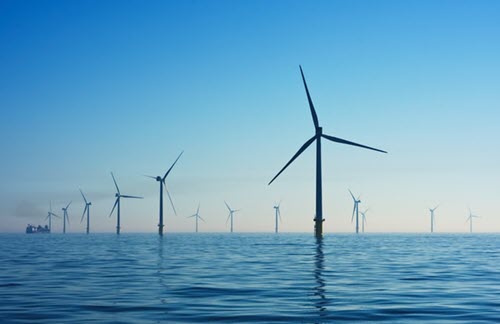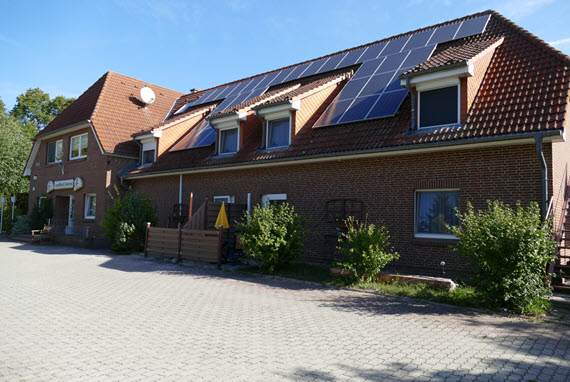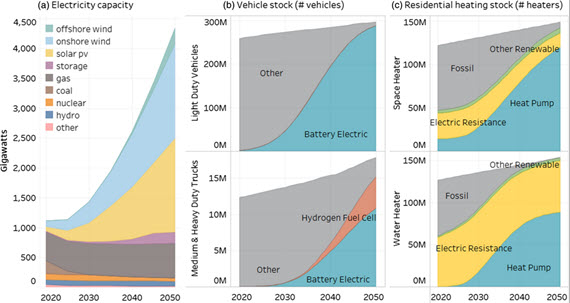Most important steps to build out a completely renewable energy system
Posted on 15 March 2021 by michael sweet
Paper: Carbon-Neutral Pathways for the United States

Figure 1: Photo by Nicholas Doherty on Unsplash
On January 21, 2021 a new paper (Williams et al. 2021) was published that claims that an energy system can provide 100% carbon free energy to power the entire economy of the USA economically. This paper describes how to build an energy system that provides all energy to the economy and releases no carbon into the atmosphere by 2050. This conclusion is similar to Jacobson et al. 2018 (Jacobson et al 2015 at SkS) and Connelly et al. 2016 previously described here at SkS. Williams et al modeled eight different scenarios representing slightly different pathways to reach net zero and net negative CO2 emissions by 2050. The cheapest option uses some fossil fuels with carbon capture and storage (CCS) and has a small amount of nuclear power. A completely renewable energy system with no fossil fuels or nuclear is slightly more expensive. Building a comparable system for other countries would be similar.
Williams et al. 2021 say:
“We created multiple blueprints for the United States to reach zero or negative CO2 emissions from the energy system by 2050 to avoid the most damaging impacts of climate change. By methodically increasing energy efficiency, switching to electric technologies, utilizing clean electricity (especially wind and solar power), and deploying a small amount of carbon capture technology, the United States can reach zero emissions without requiring changes to behavior. Cost is about $1 per person per day, not counting climate benefits; this is significantly less than estimates from a few years ago because of recent technology progress.”
This is an important paper because the group that published the paper has previously concluded that it was not economic to have a completely renewable energy system that released no carbon into the atmosphere. (Williams et al. 2019). They previously thought that nuclear power or large amounts of fossil fuels with carbon capture and storage (CCS) would be required. Because of the dramatic decrease in the cost of wind and solar energy they now conclude that a system with 100% renewable energy would be possible. Their cheapest scenario contains a small amount of nuclear and some fossil fuel with CCS.
Here is the press release from the Lawrence Berkeley National Laboratory describing the paper and a summary from Science Daily . In this OP I will describe the most important conclusions that need to be acted on and the policy choices that concerned citizens (like those at SkS) should support.
Key Conclusions
1) A complete energy system for the US economy can be built economically by 2050 that releases no CO2 to the atmosphere. The primary energy sources will be wind and solar electricity.
2) The key first steps are:
- Build out wind and solar generation as rapidly as possible.
- Convert all cars and as much additional transportation to electricity as rapidly as possible
- Implement energy conservation measures as much as is economic (primarily using electric heat pumps for heating and cooling and making buildings more energy efficient).
- Stop all new connections to fossil fuel heaters and coolers.
- Existing methane (natural gas) powered electrical generators can be used to provide energy storage and electricity on windless nights.
These key steps will be the most important items until about 2035. This will electrify about 80% of the economy. The last 20% of the economy is the hardest and is where different pathways can be considered.
The system described by Williams et al. 2021 is similar to Connolly et al. 2016. Williams 2021 models systems using biofuels, carbon capture and storage, nuclear power, wind, water and solar. A small amount of other generating sources like geothermal is used.

Figure 2: Solar panels on roof (B.Winkler)
Actions that concerned citizens should support:
1) Support rapid construction of wind and solar systems. Policy items like the production tax credit and making it easier to obtain construction permits will allow faster construction of these systems. Encouraging home and commercial rooftop solar systems adds generation capacity. Support for building transmission lines where needed. Williams et al 2021 find that wind from the Midwest can be used nationally while solar power is cheaper to generate locally.
2) Convert all cars and other transportation to electricity. Policies like the $7,500 tax credit for some electric cars can be extended to encourage people to purchase these cars. Electrify trains and trucks as much as possible. Ship long range freight on electric trains as much as possible. Build electric trains to replace short range airplane flights.
3) Convert all heating and cooling to electric heat pumps. Air conditioners are electric heat pumps. Added valves allow them to also be used for heating. My house in Florida has a heater/cooling heat pump. Heat pumps can add approximately three times as much heat for a given energy input than chemical furnaces or electrical resistance heaters. Converting to heat pumps dramatically reduces total energy use compared to chemical heaters or electrical resistance heaters. This reduces overall system costs. Heat pumps cost more than furnaces so people are resistant to installing. Heat pumps save money in the long run because they use so much less energy.
4) Stop all new connections to fossil fuel heaters. Many heaters in the USA use heating oil or natural gas. All new installations and replacements of existing units should install electric heat pumps. This saves consumers money in the long run but people object to the expense up front. Especially after 2035 oil and gas prices should be increasing to encourage heat pump use. Installing heat pumps now prevents replacing furnaces later before they have been fully used.
5) Make buildings more energy efficient. Increase building codes so that buildings are better insulated and more energy efficient. This results in a small increase in building costs but saves consumers a lot of money in the long run. Builders resist these codes.
6) Existing methane generators have about the expected capacity needed to provide backup power on windless nights in the future. Policies should not encourage shutting down methane powered generating plants. Coal plants should be shut down.
Finishing off 100% renewable energy
Decisions like how to electrify the last, hardest 20% of the economy and whether to use biofuels, electrofuels or just electricity do not need to be made at this time. More research can be done to determine the best path. Changing future costs will also determine the most cost effective path. Some amount of carbon capture is required in all scenarios.
This conclusion is similar to Connelly et al 2016. Jacobson et al 2018 does not use biofuels (he thinks it causes too much pollution) and is more stringent than Williams et al 2021. The conclusions of what is best to do for the next ten years is similar for all these papers. That is to build out wind and solar generation as fast as possible. The amounts of each can be determined economically (build whatever is cheapest).
The most costly scenario was where there was slow uptake of heat pumps and efficient buildings. This lead to greater demand for energy and much more wind and solar generators. The cost of all the scenarios was 0.2% to 1.2% of GDP. The cheapest scenario (0.2% of GDP) was one with low renewable energy cost (future cost of all technologies has to be estimated). 100% renewable energy was slightly more costly than the central scenario (.9% of GDP for 100% renewable to 0.4% of GDP for central).
After 2050, when the system would be built, the cost of energy in the economy in all scenarios would be less than the average cost of energy for the past 60 years. In addition, no money would be spent importing oil and other energy from overseas.
Figure 3: Infrastructure transition in the 'Central Scenario' illustrating the change-over to a net-zero energy system for a) electric power generating capacity, b) vehicles, and c) space and water heating. (Figure 4 from Williams et al. 2021)
Hat tip to Nigelj for bringing this article to my attention.































 Arguments
Arguments































M Sweet, glad to have helped, but I can't recall reading the article or bringing it to your attention. Where and when did I do that? However I have just posted a link to the article and the research study over on RC. We all need some good news.
www.eia.gov/beta/electricity/gridmonitor/expanded-view/electric_overview/US48/US48/GenerationByEnergySource-4/edit
Everyone knows how the Texas lost signigicant electric power generation on the early morning of Monday 2/15/2021 due to the failure of gas plant electric generation. Going from 45GW per hour down to 28 gw per hour over a period of 6 hours.
In Texas/Ercot, wind produces on average of 15GW per hour to 25GW per hour. Of note, electricity generated from wind dropped down below 5GW per hour from 2.9.2021 though 2.18.2021 often producing less than 2GW per hour with only a few times during those 9 days producing in the range of 8GW per hour. That was for a period of 9 days, though there are frequent drops in electric production from wind lasting full days, The link above shows drops down below 8GW per hour on 3.6.21, 3.3.2021, 3.6.2021. Storage is currently feasible to handle the frequene frequency when wind doesnt produce. I look forward to a solution.
David,
Williams et al 2021, the paper reviwed in the OP, primarily uses electromethane for use when there is little wind and solar. This could be stored in existing storage areas for natural gas and used in existing gas generators.
In addition, all the plans I have seen have a national or whole continent grid. Small grids like ERCOT are prone to failure when connection to a national grid would not fail. For example, during the recent shortage in Texas there might have been wind in the northern part of the country that could be delivered to Texas. The OP finds that renewable energy (primarily wind and solar) with storage is economically competitive with fossil fuels.
Recently I have seen some articles at CarbonBrief.org that suggest industry is leaning toward using hydrogen for storage. One key conclusion in the Williams et al 2021 is that we do not need to make that decision today. In any case we should build out wind and solar as rapidly as possible and switch everything over to electricity. Natural gas can provide adequate storage. In 10 years it will be clearer whether hydrogen or electromethane is a better choice for storage.
www.eia.gov/beta/electricity/gridmonitor/expanded-view/electric_overview/US48/US48/GenerationByEnergySource-4/edit
Michael - the above link shows the electric generation from wind dropped from the normal 45-70gw per hour down to 8gw - 20GW per hour across the entire US during the same period that ERCOT dropped wlectric generation from wind.( 2/8/2021 through 2/19/2021,) Germany which has one of the highest penetrations of wind generated electricy suffers from multiple days with low electric production from Wind. See the attached link which shows approx 7 days where germany's electric generation dropped from the 50-70gw per hour to less than 30gw per hour for 5-7+ days (my apologies, agora-energiewende site's charts are a little hard to read/adjust the dates)
www.agora-energiewende.de/en/service/recent-electricity-data/chart/power_generation/12.02.2021/15.03.2021/
The willaims study also includes the conversion of home heating to electric ( or at least new homes and replacement as furnaces wear out)
based on current techology and the anticipated technology, neither battery or electomethane appear to be viable options when there are 3-4+ days where electric generation drops like we experienced in the US for the 7-8+ days from February 8- feb 19th. Likewise the same issue in Germany for the 4+5 dys they experienced in Februay.
I could not find in the Williams study (or jacobson's prior studies) how they overcome those issues. If you can point to how they anticipate handling those Issues, I would appreciate the help
David,
How to store excess energy from windy days to use on windless nights is the key issue of using renewables. I am surprised that you could not find where Jacobson et al and Williams et all address long term storage. Most of both papers is dedicated to addressing this issue.
In general, there are a lot of ways to address this issue. For example, current hydro power is used to supply primarily peak power in the middle of the day. If usage of the dams was altered, hydro power could provide a lot of the backup power needed on most nights instead (solar production is pretty constant. Windless nights are the harder problem.). Batteries can be used for storage of solar power for use at night or wind energy at night for use the next day. Long term storage (from summer to winter) is generally too expensive for batteries.
Storage of gasses and liquids is much cheaper than storage of electricity. Then the gasses (or liquids) can be used to generate electricity when it is needed. According to the EIA, currently existing underground storage of natural gas is about 6,000 billion cubic feet in the USA alone. source Usage (same source) is about 70 billion cubic feet on peak days. This is about 90 days of complete supply. Either electromethane or hydrogen can be stored in existing storage. On windy days in summer you make hydrogen (or electromethane) and store it. On windless winter nights you use the gas to generate electricity in currently existing gas turbines. Fuel cells using hydrogen are more energy efficient if they are developed in the next 10 years (this technology exists. The question is the cost of scale up to the entire country). This would easily supply the examples you give. Even if electrical usage was much greater there would still be enough storage.
Your wild claim that electromethane is not a viable option is completely unsupported. The three peer reviewed papers I cite show that storage is economically available to power 100% of the economy using current technology. If fuel cells are developed than hydrogen might be cheaper.
If you have trash to energy plants they can stockpile material to use to supply peak power. A lot of energy can be saved by customers who reduce use to get cheaper electricity. Many high users of electricity currently reduce use on peak usage days. My brother programs his electric car to charge only when there is excess power since the electricity is cheaper.
Williams et al and Jacobson et al describe their systems running for 4 years without problems supplying total energy to the economy.
In addition, scientists have found that the larger the grid the less incidence of windless nights occurs.
Germany will never generate 100% of all energy all the time, it is too small. They will be in a European grid that helps back them up. Norway has tremendous hydro that could imaginally back up all Europe.
You have to look at the big picture. Deniers in the past have used examples as small as a single wind turbine to argue against renewables. Scientists have shown that large grids (the bigger the better) generating All Energy for the economy are the cheapest way to go. Texas will have to connect to the grid.